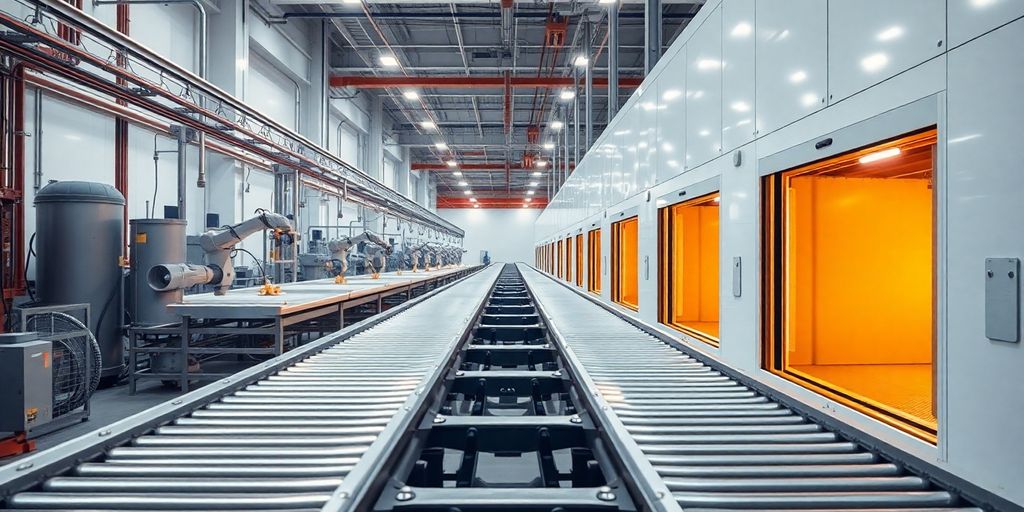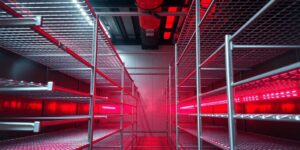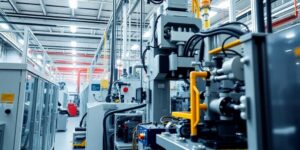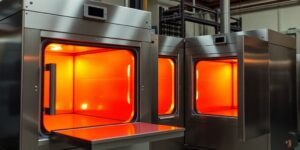Industrial Finishing Systems are pretty important in manufacturing. They help make sure products look good and last a long time. It’s not just about painting; it’s a whole process with many steps, and each step needs to work well with the others. If one part of the system isn’t doing its job, the whole thing can slow down, or the final product won’t be as good. This article will break down how these systems work, module by module, to get the most out of them.
Key Takeaways
- Getting parts ready with pre-treatment is a must for good paint adhesion.
- Moving parts smoothly through the system with conveyors helps keep things flowing.
- Using robots and smart controls can make the finishing process more consistent and reliable.
- Watching data in real-time helps find problems fast and keep the system running.
- Thinking about how to avoid slowdowns and quick changes makes the whole process faster.
Understanding the Core Components of Industrial Finishing Systems
Industrial finishing systems are complex setups, but they all share some core components. Understanding how these parts work is key to getting the best performance and throughput from your system. It’s not just about having the right equipment; it’s about how each piece interacts with the others.
Pre-Treatment Stages for Optimal Adhesion
Before you even think about applying a finish, you’ve got to prep the surface. This is where pre-treatment comes in. The goal is to create a clean, receptive surface that the coating can properly bond to. Think of it like painting a wall – you wouldn’t just slap paint on a dirty surface, would you? Pre-treatment can involve several steps:
- Cleaning: Removing dirt, oil, and other contaminants.
- Etching: Creating a slightly rough surface for better adhesion.
- Applying a conversion coating: This adds a protective layer and improves bonding.
Skipping or skimping on pre-treatment is a recipe for disaster. You might save some time and money upfront, but you’ll pay for it later with coatings that peel, chip, or corrode.
Application Booths: Precision Coating Delivery
This is where the magic happens – the coating actually gets applied to the part. Application booths come in all shapes and sizes, depending on the type of coating and the size of the parts. The key is precision. You want to apply the coating evenly and consistently, without wasting material. Common types of application methods include:
- Spray guns: These can be manual or automated, and they’re used for liquid coatings.
- Powder coating booths: These use electrostatic attraction to apply powder to the part.
- Dip tanks: The part is submerged in a tank of coating material.
Curing Ovens: Ensuring Durable Finishes
Once the coating is applied, it needs to be cured. This usually involves baking the parts in an oven at a specific temperature for a certain amount of time. The curing process hardens the coating and makes it durable. The right temperature and time are critical for achieving the desired finish properties. Think of it like baking a cake – if you don’t bake it long enough, it’ll be gooey in the middle. Here’s a quick look at some oven maintenance:
- Monthly: Check fuel safety shutoff valves, fan and airflow interlocks, and interior oven cleanliness.
- Annual: Inspect ignitor and burner components, combustion air supply system, and conduct operating sequence tests.
Proper operator training is important to ensure the curing ovens are running efficiently. The type of oven you use depends on the coating material and the size of the parts. Batch ovens are good for small volumes, while continuous ovens are better for high-volume production. You can also explore custom finishing systems for unique applications.
Optimizing Material Handling in Industrial Finishing Systems

Material handling is a big deal in industrial finishing. If parts aren’t moving smoothly, the whole process slows down. It’s like a traffic jam on the highway – everything grinds to a halt. We need to think about how parts enter the system, move through each stage (pre-treatment, coating, curing), and exit. A well-planned material handling system can seriously boost throughput and cut down on wasted time and resources. It’s not just about moving stuff; it’s about moving it efficiently and safely.
Conveyor Systems: Seamless Part Movement
Conveyor systems are the backbone of many finishing lines. They’re what keep parts moving from one station to the next. There are different types, like overhead, belt, and chain conveyors, and the best choice depends on the size, shape, and weight of the parts you’re finishing. The right conveyor system minimizes manual handling, reduces the risk of damage, and keeps the line flowing. Think about it: if you’re constantly stopping to move parts by hand, you’re losing time and money. A good conveyor system is reliable, easy to maintain, and can handle the volume of parts you’re processing. It’s an investment that pays off in increased efficiency and reduced labor costs. You can also look into material removal processes to further optimize your operations.
Automated Loading and Unloading Solutions
Manual loading and unloading can be a real bottleneck, especially with heavy or awkwardly shaped parts. Automated solutions, like robotic arms and pick-and-place systems, can speed things up and reduce the risk of injury.
Here’s why automation is a smart move:
- Increased speed and throughput
- Reduced labor costs
- Improved safety for workers
- Consistent and repeatable loading/unloading
Automated systems can be programmed to handle a variety of parts, making them flexible and adaptable to changing production needs. Plus, they can work around the clock without getting tired, which means more parts finished in less time. It’s all about maximizing efficiency and minimizing downtime.
Custom Material Handling for Diverse Products
Not all parts are created equal. Some are small and delicate, while others are large and heavy. That’s where custom material handling solutions come in. These systems are designed to handle the specific needs of your products. This might involve:
- Specialized fixtures to hold parts securely
- Custom conveyor systems to accommodate unique shapes
- Robotic grippers designed for delicate handling
A custom solution might cost more upfront, but it can save you money in the long run by reducing damage, improving efficiency, and allowing you to finish a wider range of products. It’s about finding the right balance between cost and performance to meet your specific needs.
Ultimately, the goal is to create a material handling system that’s tailored to your products and your production process. This means thinking outside the box and finding creative solutions to move parts efficiently and safely through your finishing line. It’s an investment in your future that can pay off big time in terms of increased throughput, reduced costs, and improved quality.
Integrating Automation and Control in Industrial Finishing Systems
Automation and control systems are now super important in modern industrial finishing. They help make sure everything runs smoothly, consistently, and efficiently. It’s all about using technology to get the best results.
Robotic Application for Consistency
Robots are changing the game in finishing. They can apply coatings with amazing precision, doing the same thing every single time. This means less waste, fewer errors, and a much more consistent finish quality. Plus, robots can work in environments that might be dangerous for humans, like places with fumes or high temperatures. It’s not just about replacing people; it’s about making the whole process better. If you’re looking for custom finishing systems, consider how robotics can improve your operations.
Programmable Logic Controllers (PLCs) for Process Management
PLCs are basically the brains of the operation. They control everything from the speed of the conveyor to the temperature of the curing oven. PLCs make it easy to adjust settings and monitor performance in real-time. This level of control is key to optimizing the finishing process for different materials and coatings. They also help with safety, making sure everything stays within safe operating parameters.
Here’s a quick look at what PLCs manage:
- Temperature control in ovens
- Conveyor speed regulation
- Spray booth environment
- Material flow management
Sensor Technology for Quality Assurance
Sensors are like the eyes and ears of the finishing line. They constantly monitor things like coating thickness, temperature, and humidity. If something goes wrong, the sensors can alert operators or even automatically adjust the process to correct the issue. This helps catch defects early, reducing waste and ensuring high quality.
Using sensors for quality control is a big deal. It means you can catch problems before they become major issues, saving time and money. Plus, it gives you data to analyze and improve your processes over time.
Here are some common types of sensors used:
- Thickness sensors
- Temperature sensors
- Humidity sensors
- Color sensors
Enhancing Efficiency Through Smart Industrial Finishing Systems
Real-Time Monitoring and Data Analytics
Okay, so picture this: you’re running a finishing line, and things are mostly smooth, but you’ve got this nagging feeling that there’s room to improve. That’s where real-time monitoring and data analytics come in. It’s like having a doctor constantly checking the vital signs of your system. We’re talking sensors tracking temperature, pressure, chemical concentrations – the whole shebang. This data gets fed into a system that spits out insights.
- Spotting trends before they become problems.
- Identifying bottlenecks in the process.
- Optimizing settings for different materials.
It’s not just about collecting data; it’s about turning that data into actionable intelligence. You can see exactly where things are going wrong, and more importantly, why. This allows for quick adjustments, preventing costly errors and keeping production humming.
Predictive Maintenance for Uptime Maximization
Predictive maintenance? It’s all about looking into the future. Instead of waiting for a pump to fail or a nozzle to clog, you use data to predict when these things are likely to happen. Think of it like this: your car tells you when it needs an oil change, not when the engine seizes up. By analyzing historical data and current conditions, you can schedule maintenance proactively. This minimizes downtime and extends the life of your equipment. For example, custom finishing systems can benefit greatly from this approach.
- Reduced unplanned downtime.
- Lower maintenance costs.
- Extended equipment lifespan.
Energy Optimization in Curing Processes
Curing ovens are energy hogs, plain and simple. But they don’t have to be. Smart systems can optimize energy use in a few ways. First, by precisely controlling the temperature and duration of the curing cycle. No more over-baking parts! Second, by using sensors to detect when the oven is empty and automatically reducing power consumption. Third, by implementing heat recovery systems to reuse waste heat. The result? Lower energy bills and a smaller carbon footprint. Here’s a quick look at potential savings:
| Optimization Strategy | Potential Savings | Implementation Cost | Payback Period |
|---|---|---|---|
| Precise Temp Control | 15-20% | Moderate | 1-2 years |
| Occupancy Sensors | 5-10% | Low | < 1 year |
| Heat Recovery | 20-30% | High | 3-5 years |
- Reduced energy consumption.
- Lower operating costs.
- Improved environmental performance.
Designing for Throughput: Key Considerations for Industrial Finishing Systems
Streamlining Manufacturing Operations
When thinking about throughput, it’s easy to get caught up in the finishing system itself. But, the truth is, the entire manufacturing process needs to be considered. The goal is to minimize any bottlenecks that could slow down the whole operation.
- Evaluate the current workflow to identify areas for improvement.
- Consider how the design of the product impacts the finishing process. Can it be simplified?
- Look at the upstream and downstream processes to ensure a smooth flow of materials.
A well-designed manufacturing process will make the finishing system’s job much easier, leading to higher throughput and reduced costs.
Minimizing Changeovers and Setup Times
Changeovers can be a huge drag on throughput. Every minute spent switching between products is a minute lost in production. Reducing changeover time is key. Here’s how:
- Standardize tooling and fixtures to make changeovers quicker.
- Implement a system for quick die changes.
- Use a single recipe for similar parts.
| Changeover Task | Current Time (minutes) | Target Time (minutes) |
|---|---|---|
| Tooling Change | 30 | 15 |
| Recipe Selection | 5 | 2 |
| System Calibration | 15 | 10 |
Optimizing Resource Allocation
Getting the most out of your resources is critical for maximizing throughput. This means carefully considering how you allocate labor, materials, and equipment. It’s about making sure everything is in the right place at the right time. Consider custom finishing systems to optimize your resource allocation.
- Use data to identify areas where resources are being underutilized.
- Implement a system for tracking material usage and waste.
- Cross-train employees to handle multiple tasks, providing flexibility.
Quality Control and Inspection in Industrial Finishing Systems

Quality control is super important in industrial finishing. You want to make sure everything looks good and works as it should, right? It’s not just about making things pretty; it’s about making sure the finish does its job – protecting against corrosion, wear, or whatever else it’s supposed to do. If you skip this step, you might end up with a bunch of products that fail way too soon, and nobody wants that.
Automated Inspection Systems
Okay, so manual inspection is fine for some things, but when you’re cranking out a ton of parts, you need something faster and more consistent. That’s where automated inspection comes in. These systems use cameras, lasers, and other sensors to check for defects like scratches, uneven coating thickness, or color variations. It’s way quicker than having someone eyeball every single piece, and it catches stuff that humans might miss. Plus, the data collected can be used to fine-tune the whole finishing process.
Adherence to Industry Standards
There are a bunch of industry standards out there that dictate how finishing should be done and what the final product should look like. Things like ISO, ASTM, and others. Following these standards isn’t just about ticking boxes; it’s about making sure your products meet certain performance criteria and are safe to use. It also helps with things like getting certifications and selling your stuff in different markets. Here’s a quick rundown:
- ISO 9001: Focuses on quality management systems.
- ASTM standards: Cover materials testing and specifications.
- Specific industry standards: Vary depending on the application (e.g., automotive, aerospace).
Preventative Maintenance for Consistent Performance
Think of your finishing system like a car. If you don’t change the oil and do regular check-ups, it’s gonna break down sooner or later. Same goes for finishing systems. Preventative maintenance is all about keeping things running smoothly by doing things like:
- Regularly cleaning and inspecting equipment.
- Replacing worn parts before they fail.
- Calibrating sensors and controls.
Doing this helps avoid unexpected downtime, keeps the quality consistent, and extends the life of your equipment. It’s way cheaper to prevent problems than to fix them after they happen. Don’t forget to check your curing oven basics regularly.
The Role of Software in Modern Industrial Finishing Systems
Software is now a critical part of industrial finishing systems. It’s not just about controlling machines anymore; it’s about optimizing the entire process, from start to finish. Think of it as the brain that coordinates all the moving parts, ensuring everything runs smoothly and efficiently. Let’s take a look at how software is changing the game.
ERP Integration for Production Planning
Integrating your finishing system with an ERP system is a game-changer. It allows for better production planning by providing real-time data on inventory, demand, and capacity. This integration helps in:
- Reducing lead times: By accurately forecasting demand and optimizing resource allocation.
- Minimizing waste: By ensuring the right materials are available at the right time.
- Improving customer satisfaction: By providing accurate delivery dates and meeting commitments.
Shop Floor Planning and Scheduling
Shop floor planning and scheduling software takes the data from the ERP system and turns it into actionable plans. This software helps optimize the sequence of jobs, manage resources, and track progress in real-time. It also allows for quick adjustments in response to unexpected events, such as equipment downtime or rush orders. Benefits include:
- Improved resource utilization
- Reduced bottlenecks
- Enhanced visibility into shop floor operations
Data-Driven Insights for Continuous Improvement
Modern finishing systems generate a ton of data. Software can analyze this data to identify areas for improvement. This includes:
- Process optimization: Identifying bottlenecks and inefficiencies in the finishing process.
- Quality control: Detecting defects early and preventing them from recurring.
- Predictive maintenance: Anticipating equipment failures and scheduling maintenance proactively.
By leveraging data-driven insights, companies can continuously improve their finishing processes, reduce costs, and enhance quality. This is a key competitive advantage in today’s market.
Software is super important for today’s industrial finishing systems. It helps make things run smoother and more efficiently. Want to see how our smart systems can help your business? Check out our website to learn more!
Conclusion
So, there you have it. Getting an industrial finishing system to work well means all its parts have to play nice together. It’s not just about having good equipment; it’s about making sure each step flows into the next without a hitch. When you get that right, you can make more stuff, faster, and with less waste. It’s a big deal for any business that does finishing work. Thinking about the whole system, not just individual pieces, is how you get the best results. It really makes a difference in how much you can produce.
Frequently Asked Questions
What exactly is an industrial finishing system?
Industrial finishing systems are like big factory setups that clean, paint, and dry products. They’re used to make things look good and last longer, like car parts or furniture. Think of it as a super-efficient way to give products their final look.
Why are these systems important for manufacturing?
These systems help factories make more products faster, with less waste. They also make sure every item looks the same and is of high quality. This means happier customers and more money for the business.
How do products move through the system?
It all starts with cleaning the product, then a machine sprays on the paint or coating, and finally, it goes into a special oven to dry and harden. Conveyor belts move the products along each step, making it a smooth process.
Do robots and computers play a big role?
Yes, many systems use robots to do the painting because robots can be super precise and never get tired. Computers also control everything, making sure the right amount of paint is used and the drying temperature is perfect.
How do these systems help make more products quickly?
Making the system work faster means less time waiting between steps and fewer mistakes. This is done by making sure parts move smoothly, machines are set up quickly for new jobs, and all resources are used wisely.
How do they make sure the finished product is perfect?
They use special cameras and sensors to check the quality of the finish. If something isn’t right, the system can flag it. Also, regular check-ups and fixes on the machines help prevent problems before they start, keeping everything running smoothly.

